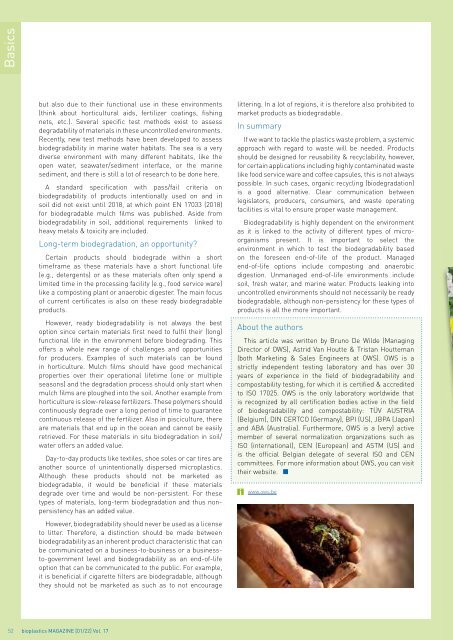issue 01/2022
Highlights: Automotive Foam Basics: Biodegradation
Highlights:
Automotive
Foam
Basics: Biodegradation
Create successful ePaper yourself
Turn your PDF publications into a flip-book with our unique Google optimized e-Paper software.
Basics<br />
but also due to their functional use in these environments<br />
(think about horticultural aids, fertilizer coatings, fishing<br />
nets, etc.). Several specific test methods exist to assess<br />
degradability of materials in these uncontrolled environments.<br />
Recently, new test methods have been developed to assess<br />
biodegradability in marine water habitats. The sea is a very<br />
diverse environment with many different habitats, like the<br />
open water, seawater/sediment interface, or the marine<br />
sediment, and there is still a lot of research to be done here.<br />
A standard specification with pass/fail criteria on<br />
biodegradability of products intentionally used on and in<br />
soil did not exist until 2<strong>01</strong>8, at which point EN 17033 (2<strong>01</strong>8)<br />
for biodegradable mulch films was published. Aside from<br />
biodegradability in soil, additional requirements linked to<br />
heavy metals & toxicity are included.<br />
Long-term biodegradation, an opportunity?<br />
Certain products should biodegrade within a short<br />
timeframe as these materials have a short functional life<br />
(e.g., detergents) or as these materials often only spend a<br />
limited time in the processing facility (e.g., food service ware)<br />
like a composting plant or anaerobic digester. The main focus<br />
of current certificates is also on these ready biodegradable<br />
products.<br />
However, ready biodegradability is not always the best<br />
option since certain materials first need to fulfil their (long)<br />
functional life in the environment before biodegrading. This<br />
offers a whole new range of challenges and opportunities<br />
for producers. Examples of such materials can be found<br />
in horticulture. Mulch films should have good mechanical<br />
properties over their operational lifetime (one or multiple<br />
seasons) and the degradation process should only start when<br />
mulch films are ploughed into the soil. Another example from<br />
horticulture is slow-release fertilizers. These polymers should<br />
continuously degrade over a long period of time to guarantee<br />
continuous release of the fertilizer. Also in pisciculture, there<br />
are materials that end up in the ocean and cannot be easily<br />
retrieved. For these materials in situ biodegradation in soil/<br />
water offers an added value.<br />
Day-to-day products like textiles, shoe soles or car tires are<br />
another source of unintentionally dispersed microplastics.<br />
Although these products should not be marketed as<br />
biodegradable, it would be beneficial if these materials<br />
degrade over time and would be non-persistent. For these<br />
types of materials, long-term biodegradation and thus nonpersistency<br />
has an added value.<br />
However, biodegradability should never be used as a license<br />
to litter. Therefore, a distinction should be made between<br />
biodegradability as an inherent product characteristic that can<br />
be communicated on a business-to-business or a businessto-government<br />
level and biodegradability as an end-of-life<br />
option that can be communicated to the public. For example,<br />
it is beneficial if cigarette filters are biodegradable, although<br />
they should not be marketed as such as to not encourage<br />
littering. In a lot of regions, it is therefore also prohibited to<br />
market products as biodegradable.<br />
In summary<br />
If we want to tackle the plastics waste problem, a systemic<br />
approach with regard to waste will be needed. Products<br />
should be designed for reusability & recyclability, however,<br />
for certain applications including highly contaminated waste<br />
like food service ware and coffee capsules, this is not always<br />
possible. In such cases, organic recycling (biodegradation)<br />
is a good alternative. Clear communication between<br />
legislators, producers, consumers, and waste operating<br />
facilities is vital to ensure proper waste management.<br />
Biodegradability is highly dependent on the environment<br />
as it is linked to the activity of different types of microorganisms<br />
present. It is important to select the<br />
environment in which to test the biodegradability based<br />
on the foreseen end-of-life of the product. Managed<br />
end-of-life options include composting and anaerobic<br />
digestion. Unmanaged end-of-life environments include<br />
soil, fresh water, and marine water. Products leaking into<br />
uncontrolled environments should not necessarily be ready<br />
biodegradable, although non-persistency for these types of<br />
products is all the more important.<br />
About the authors<br />
This article was written by Bruno De Wilde (Managing<br />
Director of OWS), Astrid Van Houtte & Tristan Houtteman<br />
(both Marketing & Sales Engineers at OWS). OWS is a<br />
strictly independent testing laboratory and has over 30<br />
years of experience in the field of biodegradability and<br />
compostability testing, for which it is certified & accredited<br />
to ISO 17025. OWS is the only laboratory worldwide that<br />
is recognized by all certification bodies active in the field<br />
of biodegradability and compostability: TÜV AUSTRIA<br />
(Belgium), DIN CERTCO (Germany), BPI (US), JBPA (Japan)<br />
and ABA (Australia). Furthermore, OWS is a (very) active<br />
member of several normalization organizations such as<br />
ISO (international), CEN (European) and ASTM (US) and<br />
is the official Belgian delegate of several ISO and CEN<br />
committees. For more information about OWS, you can visit<br />
their website.<br />
www.ows.be<br />
52 bioplastics MAGAZINE [<strong>01</strong>/22] Vol. 17

















